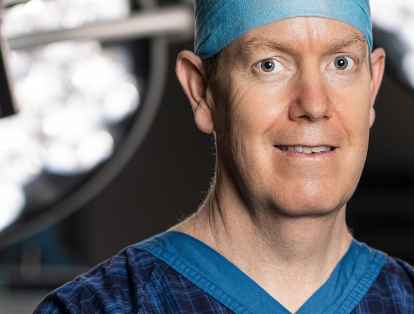Introduction
Large Aortic Aneurysms (AAA) are a potentially life-threatening danger. Once over 5.5 cm in diameter they should be treated. Traditionally an open surgical repair was the only option to treat AAA. Whilst a very effective operation, open aortic surgery is a major surgical procedure and as AAA are more common in the elderly, who tend to have other medical issues, the risks of such surgery are not insignificant.
To reduce the risk of surgery, endovascular stenting has developed. This is a minimally invasive (keyhole) procedure that has significantly lower risks at the time of surgery. With an endovascular stent, a fabric covered stent is placed within the AAA to reline the vessel and therefore exclude the weaker part of the aortic wall to prevent ongoing enlargement and rupture. Not all patients are suitable, depending on the anatomical configuration of the AAA. The main benefit is lower risk of the surgery, quicker recovery, less time in hospital and less time in the Intensive Care Unit (ICU).
Endovascular stents do require more surveillance in the post-operative years and there is a higher need for re-interventions. This varies considerably and in part reflects the original anatomical configuration of the AAA. Due to the surveillance and potential re-intervention issues, in younger patients without significant health issues open surgical repair should be considered.
Indications
Aortic aneurysms that are 5.5cm in diameter in men and 5cm in women, or AAA that are growing rapidly, should be considered for repair. Most aneurysms are detected incidentally on USS or CT scanning. A formal CT angiogram is required to assess the best options for treatment as well as confirm the size of the AAA, Investigations to assess cardiac, respiratory and kidney function will usually be performed to help guide the best treatment option.
Preoperative Instructions
Blood thinning and diabetic medications will need to be reviewed prior to admission for surgery. Fasting requirements for the procedure will be advised. Usually, day of surgery admission is arranged. Surgery takes approximately 90 minutes. Prior to surgery commencing the anaesthetist will insert several cannulas to administer the anaesthetic and allow appropriate monitoring. A catheter will be inserted into the bladder to allow careful monitoring of urine output, a very good indicator of fluid balance and kidney function. Mostly a general anaesthetic is utilised for the surgery.
Procedure
The surgery utilises x-ray imaging to allow positioning of the stent graft. The graft is inserted by small 1 cm incisions in each groin. A device is used to place sutures into the artery before the main graft is inserted. The graft is usually a 3-piece system, with a main body that sits at the top of the aneurysm and then 2 leg extensions that pass down toward each groin region. This allows adjustment to the position of the stents within the aneurysm.
The stent graft is a self-expanding system, that acts like a spring, and once deployed it expands to sit inside the normal aorta immediately above the AAA. Angiographic images are taken at the time to allow precise positioning. Once the graft is in position a balloon is used to help fully expand the graft and to ensure the graft has good contact with the artery at all of the seal points.
A completion angiogram is performed to ensure the graft is correctly positioned and that the aneurysm has been adequately sealed from blood flow. The groin wounds are then closed and the patient is then transferred to the intensive care unit for monitoring.
Postoperative Instructions
Routine care is provided in the intensive care unit. This facilitates close monitoring of all vital signs including blood pressure and urine output. It is possible to eat and drink after 4 hours providing observations remain stable.
The following morning most of the monitoring lines can be removed and the patient will be transferred to the ward. A normal diet is commenced and mobilising around the ward is commenced. Most patients will be suitable for discharge 2-3 days post surgery.
A follow-up appointment will be scheduled for 2 weeks post discharge and an ultrasound scan of the stent is usually performed at 6 weeks. A regular surveillance program will then be commenced with the interval of appointments and scans depending on the nature of the AAA and stent. This will be determined after each scan.
Risks
Abdominal aortic aneurysm stent grafting is a safe and low risk procedure, but as with all procedures potential complications may occur.
The more frequent complications include:
- Allergic reaction to x-ray dye or anaesthetic medications.
- Bleeding – the graft does require a large tube to be inserted in each groin and this has the potential for major bleeding. Re-operation would be required in this uncommon situation.
- Wound infection.
- Inadequate seal of the AAA (endoleak) – this would require further imaging and potentially further procedures depending on the nature of the problem.
- Inadequate blood flow – the blood flow to the legs passes through the stent and there is the potential for the limbs of the stent to occlude. This uncommon situation can occur if the arteries are diseased or very tortuous. Re-operation would be required in this situation.
- Cardiac, respiratory or kidney – whilst uncommon from endovascular stenting, it is possible to cause a deterioration of pre-existing heart, lung or kidney problems.
- Deep vein thrombosis.
Treatment Alternatives
Large abdominal aortic aneurysms are a risk to life. There are no non-surgical ways to treat such an aneurysm. It is appropriate to weigh up the risks of surgical treatment vs the risk of aneurysm rupture. Open surgical repair is an alternative option and will be considered if the aneurysm is not ideally suited to endovascular stenting.
Related Information
Aortic Aneurysm Open Repair
Abdominal Aortic Aneurysms
Thoracic Aortic Aneurysms
